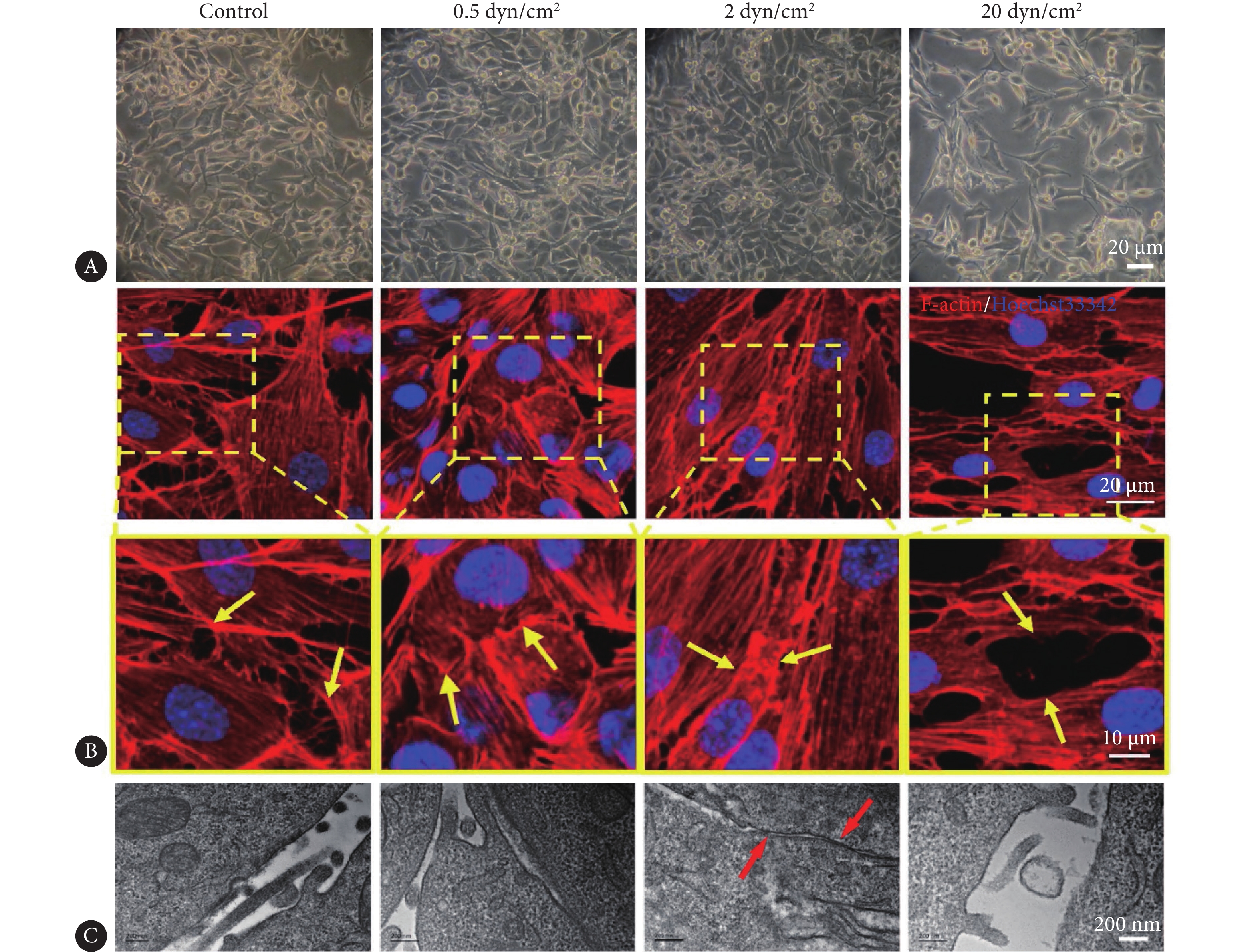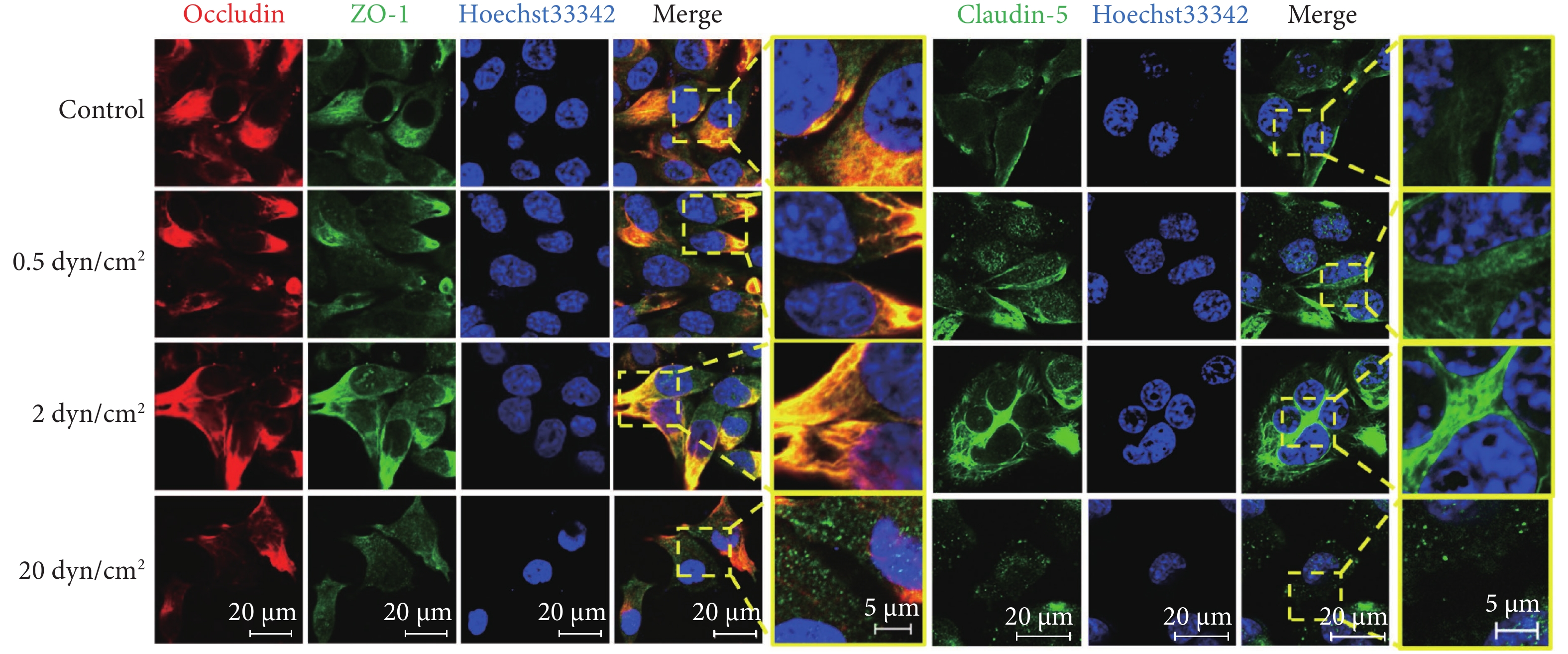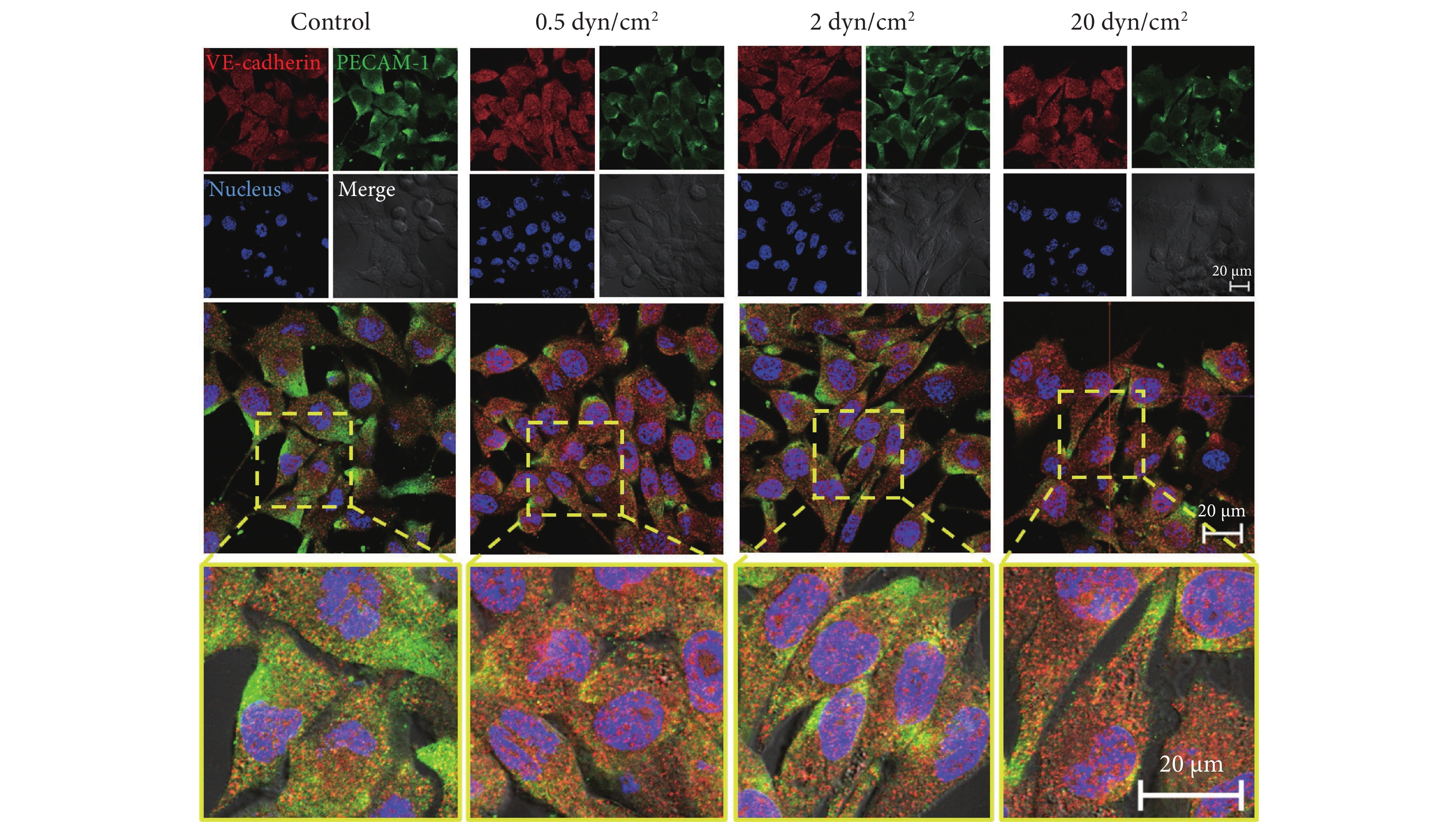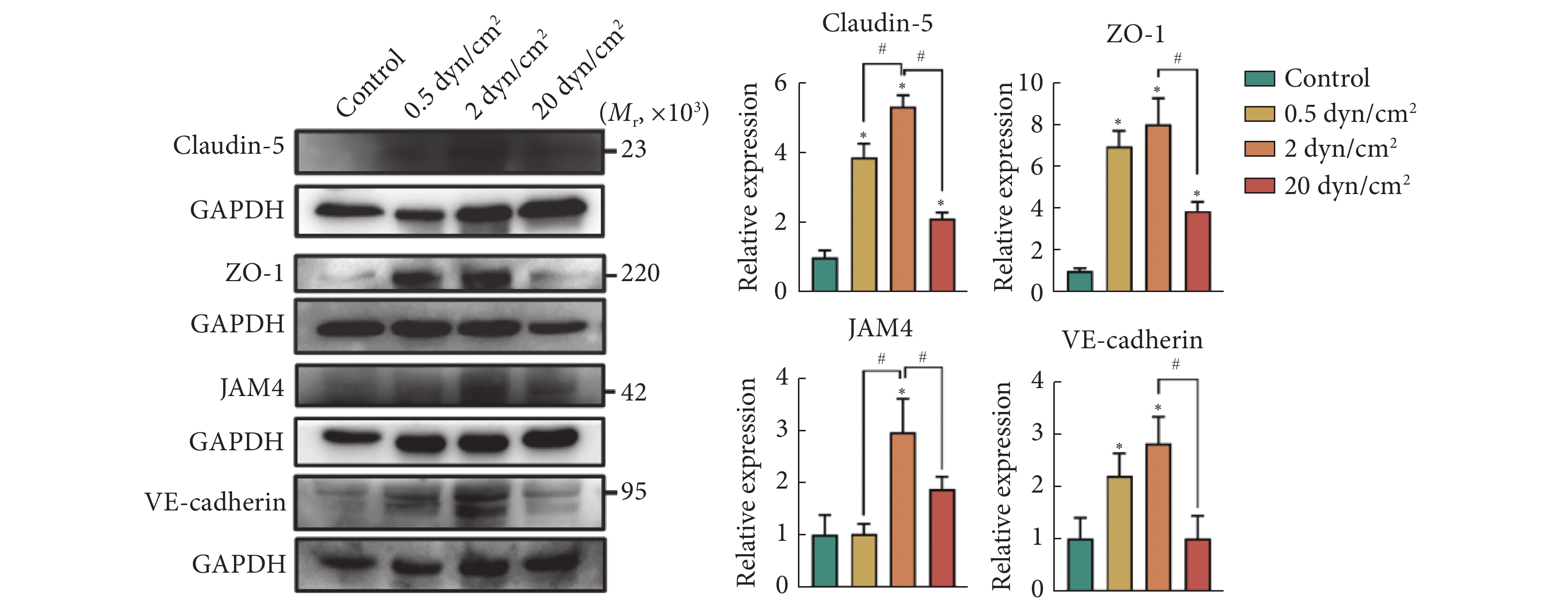Mechanobiological Mechanisms Involved in the Regualation of the Blood-Brain Barrier by Fluid Shear Force
-
摘要:目的
血脑屏障(blood-brain barrier, BBB )主要由脑微血管内皮细胞组成。本研究以大鼠脑微血管内皮细胞(rat brain microvascular endothelial cells, rBMECs)为模式细胞,探索正常生理、缺血低灌注和术后高灌注条件下的流体剪切力(flow shear force, FSF)对 BBB 结构功能的保护、损伤和破坏的力学生物学机制。
方法以1×105细胞/cm2的密度接种rBMECs培养48 h,对rBMECs分别施加0.5、2和20 dyn/cm2的FSF,模拟脑血管狭窄的低灌注、正常生理和搭桥术后高剪切力作用下BBB结构的受力情况;同时设置静态培养组rBMECs作为对照(不施加力)。光学显微镜、扫描电子显微镜(SEM)以及激光共聚焦显微镜(LSCM)观察细胞形态和骨架的变化。透射电子显微镜(TEM)观察细胞紧密连接,免疫荧光染色检测紧密连接相关蛋白(claudin-5、occludin、ZO-1)、黏着连接相关蛋白(VE-cadherin、PECAM-1)分布的变化。Western blot检测不同强度FSF下紧密连接相关蛋白(claudin-5、ZO-1、JAM4),黏着连接相关蛋白(VE-cadherin)和Rho GTPases信号关键蛋白(Rac1、Cdc42、RhoA)的表达。
结果镜下观察发现:静态培养和低剪切作用(0.5 dyn/cm2)下细胞骨架排列紊乱,取向无规律;正常生理剪切作用(2 dyn/cm2)下,细胞骨架顺应FSF方向重排,胞间观察到有效的紧密连接结构;高剪切作用(20 dyn/cm2)下,细胞间间隙增大,未观察到有效的紧密连接结构。免疫荧光染色发现低剪切作用时,细胞间距减小,但胞间连接处紧密连接相关蛋白和黏着连接相关蛋白分布较少;正常生理条件下细胞连接紧密,大部分紧密连接相关蛋白的分布集中在胞间连接处;高剪切作用时,胞间距离显著增大,连接紧密和黏着连接的结构被破坏。Western blot结果发现:低剪切作用下,claudin-5、ZO-1和VE-cadherin与对照组相比均上调(P<0.05);正常生理剪切作用下,claudin-5、ZO-1、JAM4以及VE-cadherin与对照组相比均呈现高表达(P<0.05);高剪切作用下,claudin-5、ZO-1、JAM4以及VE-cadherin的表达与正常生理剪切作用组比较下调(P<0.05);生理条件下胞内的Rho GTPases(Rac1、Cdc42、RhoA)表达上调,高于其他实验组(P<0.05),而低剪切和高剪切作用下的Rho GTPases表达均较正常生理剪切作用组下调(P<0.05)。
结论正常生理条件下的FSF有助于维持BBB结构的完整性,而低剪切或高剪切均会损伤或破坏血脑屏障的结构,FSF对BBB的调控与紧密连接相关蛋白和黏着连接相关蛋白的表达和分布密切相关。
-
关键词:
- 血脑屏障 /
- 流体剪切力 /
- 大鼠脑微血管内皮细胞 /
- 紧密连接相关蛋白 /
- 黏着连接相关蛋白
Abstract:ObjectiveTo explore the mechanobiological mechanism of fluid shear force (FSF) on the protection, injury, and destruction of the structure and function of the blood-brain barrier (BBB) under normal physiological conditions, ischemic hypoperfusion, and postoperative hyperperfusion conditions. BBB is mainly composed of brain microvascular endothelial cells. Rat brain microvascular endothelial cells (rBMECs) were used as model cells to conduct the investigation.
MethodsrBMECs were seeded at a density of 1×105 cells/cm2 and incubated for 48 h. FSF was applied to the rBMECs at 0.5, 2, and 20 dyn/cm2, respectively, simulating the stress BBB incurs under low perfusion, normal physiological conditions, and high FSF after bypass grafting when there is cerebral vascular stenosis. In addition, a rBMECs static culture group was set up as the control (no force was applied). Light microscope, scanning electron microscope (SEM), and laser confocal microscope (LSCM) were used to observe the changes in cell morphology and cytoskeleton. Transmission electron microscope (TEM) was used to observe the tight junctions. Immunofluorescence assay was performed to determine changes in the distribution of tight junction-associated proteins claudin-5, occludin, and ZO-1 and adherens junction-associated proteins VE-cadherin and PECAM-1. Western blot was performed to determine the expression levels of tight junction-associated proteins claudin-5, ZO-1, and JAM4, adherens junction-associated protein VE-cadherin, and key proteins in Rho GTPases signaling (Rac1, Cdc42, and RhoA) under FSF at different intensities.
ResultsMicroscopic observation showed that the cytoskeleton exhibited disorderly arrangement and irregular orientation under static culture and low shear force (0.5 dyn/cm2). Under normal physiological shear force (2 dyn/cm2), the cytoskeleton was rearranged in the orientation of the FSF and an effective tight junction structure was observed between cells. Under high shear force (20 dyn/cm2), the intercellular space was enlarged and no effective tight junction structure was observed. Immunofluorescence results showed that, under low shear force, the gap between the cells decreased, but there was also decreased distribution of tight junction-associated proteins and adherens junction-associated proteins at the intercellular junctions. Under normal physiological conditions, the cells were tightly connected and most of the tight junction-associated proteins were concentrated at the intercellular junctions. Under high shear force, the gap between the cells increased significantly and the tight junction and adherens junction structures were disrupted. According to the Western blot results, under low shear force, the expression levels of claudin-5, ZO-1, and VE-cadherin were significantly up-regulated compared with those of the control group (P<0.05). Under normal physiological shear force, claudin-5, ZO-1, JAM4, and VE-cadherin were highly expressed compared with those of the control group (P<0.05). Under high shear force, the expressions of claudin-5, ZO-1, JAM4, and VE-cadherin were significantly down-regulated compared with those of the normal physiological shear force group (P<0.05). Under normal physiological shear force, intercellular expressions of Rho GTPases proteins (Rac1, Cdc42, and RhoA) were up-regulated and were higher than those of the other experimental groups (P<0.05). The expressions of Rho GTPases under low and high shear forces were down-regulated compared with that of the normal physiological shear force group (P<0.05).
ConclusionUnder normal physiological conditions, FSF helps maintain the integrity of the BBB structure, while low or high shear force can damage or destroy the BBB structure. The regulation of BBB by FSF is closely related to the expression and distribution of tight junction-associated proteins and adherens junction-associated proteins.
-
缺血性脑卒中是一种因脑部血管阻塞而引起相应供血部位损伤的疾病,严重的脑血管狭窄或闭塞患者需要血管搭桥手术进行治疗,重建闭塞脑血管的血供[1]。由于患者病变血管长期暴露于低灌注和低剪切的应力环境,进行血管搭桥手术治疗后,颅内搭桥段血管血流量的迅速增加引起血流剪切力和灌注压急剧增大,导致血管末端血脑屏障(blood-brain barrier, BBB)严重破坏,严重者颅内出血后死亡[2]。
BBB维持脑部微环境动态平衡,主要由脑微血管内皮细胞(brain microvascular endothelial cells, BMECs)构成[3]。BMECs通过多种机械感受器和换能器响应切向流体剪切力和周壁拉伸力,调节维持血管张力和稳态功能的各种途径[4]。在持续的流体剪切力(fluid shear force, FSF)作用下,脑血管内BMECs顺应FSF方向排列[5]。在正常生理状态下血流剪切力对BBB的保护机制,长期缺血低灌注下BBB的慢性损伤以及搭桥术后高剪切力作用下对BBB破坏的确切机制尚未明确。本实验以大鼠脑微血管内皮细胞(rat brain microvascular endothelial cells, rBMECs)为模式细胞,分别施加0.5(低剪切力)、2(生理剪切水平)和20 dyn/cm2 (高剪切力)的剪切力,模拟脑血管狭窄的低灌注、正常生理和搭桥术后高剪切力作用下BBB 的受力情况,观察细胞骨架和细胞间紧密连接(tightjunctions, TJs)和黏着连接(adherensjunctions, AJs)结构的变化以及相关蛋白表达和分布的影响,对FSF调控血脑屏障的力学生物学机制进行初步探索。
1. 材料与方法
1.1 主要材料和试剂
rBMECs细胞株(吉妮欧生物科技有限公司,广州),Transwell®通透膜(Corning,美国),人血浆纤维连接蛋白(fibronectin, FN)(Gibco,美国),Gluta固定液(索莱宝科技有限公司,北京),四甲基异硫氰酸罗丹明(TRITC)标记的鬼笔环肽(phalloidin)(索莱宝科技有限公司,北京),Hoechst
33342 染色液(贝博生物科技有限公司,上海),812包埋剂(SPI,美国),claudin-5兔单克隆抗体(Abcam,英国),occludin小鼠单克隆抗体(Proteintech,美国),VE-cadherin兔多克隆抗体(Abcam,英国),PECAM-1小鼠单克隆抗体(Abcam,英国),ZO-1兔多克隆抗体(Affinity Biosciences,美国),JAM4小鼠单克隆抗体(Santa Cruz Biotechnology,美国),Rac1兔多克隆抗体(Santa Cruz Biotechnology,美国),Cdc42兔多克隆抗体(Abcam,英国),RhoA兔单克隆抗体(Cell Signaling Technology,美国),GAPDH兔多克隆抗体(Signalway Antibody,美国)。1.2 确定rBMECs体外培养条件
Transwell小室培养rBMECs,设置3种不同接种密度(1×104细胞/cm2,3×104细胞/cm2和1×105细胞/cm2),在接种后12、24、36、48、60 h观察细胞形态,测量细胞层的跨内膜电阻(transendothelial electrical resistance, TEER)确定rBMECs体外培养条件,测量TEER的方法见文献[6]。研究表明,当TEER大于700 Ω·cm2时意味着rBMECs间形成了较为紧密的连接[7]。结果发现,在接种后的较短时间内,TEER处于较低的水平,随着细胞趋于融合,TEER随之上升。其中,在1×105细胞/cm2密度接种的情况下,48 h后TEER大于700 Ω·cm2,因此我们在后续的实验中选定1×105细胞/cm2的密度接种48 h的培养条件。
1.3 FSF加载实验
接种细胞至载玻片上,放入流动腔中,安装循环灌流系统(灌流量为100~150 mL)。以静态培养为对照,对rBMECs持续2 h加载0.5、2、20 dyn/cm2的FSF(1 dyn/cm2=0.1 Pa)作为缺血低灌注、正常生理和搭桥术后高灌注状态下的受力情况。对不同强度的FSF加载后的rBMECs进行下述检测。
1.3.1 光学显微镜和SEM观察细胞形态
力学加载后,倒置相差显微镜(CK X 41型,Olympus,日本)观察细胞形态,拍照记录。
力学加载后,Gluta固定液固定,乙醇梯度脱水。临界点干燥仪(EM CPD300型,Leica,德国)干燥。离子溅射仪(MC1000型,HITACHI,日本)喷金。SEM(SU3500型,HITACHI,日本)观察并拍照记录。
1.3.2 激光共聚焦显微镜(LSCM)下观察细胞骨架免疫荧光F-actin染色
力学加载后,体积分数为4%多聚甲醛固定,0.5% Triton X-100溶液透膜,TRITC标记的F-actin抗体(1∶200)以及Hoechst
33342 室温避光孵育,LSCM荧光观察并拍照记录。1.3.3 TEM观察细胞TJs
力学加载后,Gluta固定液固定,刮下细胞离心,重复固定二次,乙醇梯度脱水,包埋剂渗透过夜。包埋板37 ℃过夜,60 ℃放置48 h。超薄切片机(UC7型,Leica,德国)切割样品为60~80 nm的薄片后捞片。2%醋酸铀饱+酒精溶液和枸橼酸铅溶液染色,室温干燥过夜。TEM(JEM-2100 Plus型,JEOL,日本)观察,采集图像分析。
1.3.4 免疫荧光染色检测紧密连接相关蛋白、黏着连接相关蛋白分布的变化
力学加载后,多聚甲醛固定,室温封闭,一抗claudin-5(1∶200)、occludin(1∶200)、VE-cadherin(1∶200)、PECAM-1(1∶200)、ZO-1(1∶200)4 ℃孵育过夜。荧光二抗室温以及Hoechst
33342 避光孵育,LSCM荧光观察并拍照记录。1.3.5 Western blot
力学加载后,裂解细胞离心,测定蛋白浓度,变性蛋白。电泳后转膜,5%脱脂牛奶(TBST溶解)室温封闭,一抗claudin-5〔(1∶500),ZO-1(1∶500),JAM4(1∶200),VE-cadherin(1∶500),Rac1(1∶100),Cdc42(1∶
1000 ),RhoA(1∶1000 ),内参GAPDH(1∶5000 )〕4 ℃孵育过夜。二抗反应液室温孵育。ECL显影液显色,化学发光成像系统检测。Image LabTM 5.0软件分析灰度值。以各组条带与内参条带灰度值的比值,为目的蛋白的相对表达量。1.4 统计学方法
数据以$ \bar x \pm s $的形式表示。所有实验均重复3次或3次以上。多组间数据比较采用one-way ANOVA,Tukey's进行事后检验。 P<0.05为组间差异有统计学意义。
2. 结果
2.1 FSF对于rBMECs细胞形态、细胞骨架F-actin及TJs的影响
结果如图1所示:静态培养(0 dyn/cm2)和低剪切(0.5 dyn/cm2)作用下的rBMECs排列方向无规律,细胞间距较大,骨架清晰;正常生理剪切(2 dyn/cm2)可诱导rBMECs顺应FSF方向排列,细胞边缘形成有效的相互嵌合的“闭合”状TJs结构(图1C中红色箭头所示);高剪切(20 dyn/cm2)作用下胞间间隙显著增大,TJs结构被破坏。结果表明:正常生理条件下的FSF有助于维持细胞紧密连接,而低或高剪切均会损伤或破坏细胞紧密连接。
![]() 图 1 光学显微镜(A)、免疫荧光染色(B)和TEM(C)观察rBMECs在FSF作用下的形态变化Figure 1. Morphological changes of rBMECs under the effect of FSF were observed by light microscopy (A), immunofluorescence assay (B), and TEM (C)B, The yellow arrows indicate the cell gap; red: F-actin; blue: nucleus. C, The red arrows indicate the TJ structure.
图 1 光学显微镜(A)、免疫荧光染色(B)和TEM(C)观察rBMECs在FSF作用下的形态变化Figure 1. Morphological changes of rBMECs under the effect of FSF were observed by light microscopy (A), immunofluorescence assay (B), and TEM (C)B, The yellow arrows indicate the cell gap; red: F-actin; blue: nucleus. C, The red arrows indicate the TJ structure.2.2 免疫荧光染色检测FSF对于rBMECs紧密连接相关蛋白claudin-5、occludin、ZO-1分布的影响
结果如图2所示:在对照组中,claudin-5主要分布在胞膜区,occludin和ZO-1在胞膜和胞质区域均有分布,occludin相较于ZO-1更多分布在胞膜上,细胞间隙较大,连接不紧密;低剪切(0.5 dyn/cm2)作用时,细胞间距减小,但胞间连接处紧密连接相关蛋白分布较少;正常生理条件下(2 dyn/cm2)细胞连接紧密,大部分紧密连接相关蛋白的分布集中在胞间连接处;高剪切(20 dyn/cm2)作用时,TJs结构被破坏,胞间距离显著增大。该结果表明:正常生理条件下的FSF有助于维持细胞紧密连接相关蛋白结构的完整性,而低或高剪切均会损伤或破坏紧密连接相关蛋白的结构。
2.3 免疫荧光实验检测FSF对于rBMECs黏着连接相关蛋白VE-cadherin、PECAM-1分布的影响
结果如图3所示:对照组中,VE-cadherin和PECAM-1在胞膜和胞质区域均有分布,细胞间隙较大,连接不紧密;低剪切(0.5 dyn/cm2)作用时,细胞间距减小,但胞间连接处VE-cadherin、PECAM-1分布较少;正常生理条件下(2 dyn/cm2)细胞连接紧密,大部分VE-cadherin、PECAM-1集中在胞间连接处;高剪切(20 dyn/cm2)作用时,AJs结构被破坏,胞间距离显著增大。该结果表明:正常生理条件下的FSF有助于维持细胞黏着连接相关蛋白结构的完整性,而低或高剪切均会损伤或破坏黏着连接相关蛋白的结构。
2.4 Western blot检测FSF对rBMECs紧密连接和黏着连接相关蛋白表达的影响
结果如图4所示:低剪切(0.5 dyn/cm2)作用下,claudin-5、ZO-1和VE-cadherin与对照组相比均上调(P<0.05);正常生理剪切(2 dyn/cm2)作用下,claudin-5、ZO-1、JAM4以及VE-cadherin与对照组相比均呈现高表达(P<0.05);高剪切(20 dyn/cm2)作用下,claudin-5、ZO-1、JAM4以及VE-cadherin的表达与2 dyn/cm2组比较下调(P<0.05)。该结果表明:正常生理条件下的FSF有助于紧密连接相关蛋白和黏着连接相关蛋白的高表达,而低或高剪切均会使两类蛋白表达降低。
![]() 图 4 Western blot检测不同强度FSF刺激2 h后,紧密连接相关蛋白claudin-5、ZO-1、JAM4和黏着连接相关蛋白VE-cadherin的表达Figure 4. Western blot was performed to determine the expression of tight junction-associated proteins claudin-5, ZO-1, and JAM4 and adherens junctions-associated protein VE-cadherin under different intensities of FSF for 2 h* P<0.05, vs, control group; # P<0.05. n=3.
图 4 Western blot检测不同强度FSF刺激2 h后,紧密连接相关蛋白claudin-5、ZO-1、JAM4和黏着连接相关蛋白VE-cadherin的表达Figure 4. Western blot was performed to determine the expression of tight junction-associated proteins claudin-5, ZO-1, and JAM4 and adherens junctions-associated protein VE-cadherin under different intensities of FSF for 2 h* P<0.05, vs, control group; # P<0.05. n=3.2.5 Western blot检测Rho GTPases信号关键蛋白的表达
Rho GTPases的表达如图5所示:低剪切(0.5 dyn/cm2)作用下,Cdc42和RhoA蛋白表达上调(与对照组相比);正常生理剪切(2 dyn/cm2)作用下,Rac1、Cdc42和RhoA呈现高表达,高于其他实验组;高剪切(20 dyn/cm2)作用下,Rac1和RhoA的表达相较于2 dyn/cm2组下调。该结果同样证实了:Integrin响应力学刺激后,调节Rho GTPases的表达。
3. 讨论
脑微血管内皮细胞作为血脑屏障的主要部分,通过TJs等调节底物进出,维持脑微环境稳定[8]。研究表明,血流动力学因素会显著影响血脑屏障的结构和功能。短暂性脑缺血损伤血脑屏障,而治疗后的脑血管再通引起的相对高灌注可能会对抗脑血流返回的有益作用[9],加重血脑屏障损伤,相较于此,生理剪切条件能够保护血脑屏障。本研究分别模拟缺血低灌注、正常生理和术后高灌注环境对rBMECs的影响,以探究rBMECs对不同强度FSF的响应。结果表明,生理条件下的FSF有利于rBMECs的紧密连接,而低剪切或高剪切作用均使胞间TJs结构破坏。
BMECs通过形成大量TJ以及与相邻BMECs的一些AJs来降低细胞旁通透性,维持血脑屏障结构的完整[10-12]。TJs包括跨膜蛋白如claudins、occludin、JAMs以及胞质蛋白ZOs等,AJs包括VE-cadherin、PECAM-1等[13]。研究发现,FSF可诱导BMECs中紧密和黏附的连接蛋白和基因显著上调[14]。本研究通过免疫荧光和Western blot实验探究了不同大小FSF通过TJs和黏着连接相关蛋白对血脑屏障的调控机制。结果证实,生理条件下紧密连接相关蛋白claudin-5、occludin、ZO-1和黏着连接相关蛋白VE-cadherin、PECAM-1多定位于胞间连接处,蛋白表达量高;低剪切或高剪切作用下,TJs和黏着连接相关蛋白在胞间连接处定位较少,且蛋白表达水平下降。WALSH等[15]研究发现BMECs在10 dynes/cm2的作用下, ZO-1在细胞边界定位显著增强,而当FSF降低至1 dynes/cm2时,ZO-1定位减弱且不连续。GARCIA-POLITE等[16]发现高剪切应力(40 dyn/cm2)可下调ZO-1和claudin-5总表达,严重损伤血脑屏障。因此,正常生理条件的FSF有助于维持血脑屏障结构的完整,而低剪切或高剪切均会损伤或破坏血脑屏障。
VE-cadherin的跨膜结构域与VEGF受体VEGFRs直接连接可形成力学感受器[17]。其中,VE-cadherin可介导BMECs之间的黏附作用并调节BBB功能[18]。TIMMERMAN等[19]指出,VE-cadherin通过Rac1的连接将生理剪切信号传递到紧密连接闭塞素中,从而维持内皮屏障功能稳定。本研究也显示,生理条件下胞内的Rho GTPases(Rac1,Cdc42,RhoA)表达显著上调,而低剪切和高剪切作用下的Rho GTPases表达均显著下调。由此推断得出,正常生理条件下,来自血液的FSF直接作用于由VE-cadherin所构成的机械感觉复合物,感受器将信号传递给Rho GTPases,引起其表达上调;而在长期缺血低灌注或搭桥术后骤变为高剪应力时,力学信号会抑制Rho GTPases的表达。
TADDEI等[20]研究发现AJ和TJ成分之间存在直接的细胞特异性关系。VE-cadherin的聚集可促进紧密连接相关蛋白claudin-5的转录。因此,当流场强度变化时,rBMECs上的力学感受器VE-cadherin-VEGFRs传递信号至胞内,引起VE-cadherin易位和表达降低,进而抑制TJs相关蛋白claudin-5、ZO-1、JAM4等的转录,最终导致TJs和AJs结构损伤,引起细胞膜通透性改变。
综上所述,正常生理强度的FSF(2 dyn/cm2)可保护血脑屏障结构和功能,而过低或过高的FSF均会损伤血脑屏障。其中,FSF通过调控TJs和黏着连接相关蛋白的表达和分布来调节细胞间的连接与细胞膜的功能,进而影响血脑屏障的结构。但细胞力学相关的信号通路具有复杂性,关于血脑屏障响应FSF变化的机制仍有待进一步探究。
* * *
作者贡献声明 杜聆语负责数据审编、初稿写作和审读与编辑写作,许博文负责正式分析和验证,程琳负责调查研究和可视化,岳红燕负责研究方法,张怀奕负责软件,沈阳负责论文构思、经费获取、研究项目管理、提供资源和监督指导。所有作者已经同意将文章提交给本刊,且对将要发表的版本进行最终定稿,并同意对工作的所有方面负责。
Author Contribution DU Lingyu is responsible for data curation, writing--original draft, and writing--review and editing. XU Bowen is responsible for formal analysis and validation. CHENG Lin is responsible for investigation and visualization. YUE Hongyan is responsible for methodology. ZHANG Huaiyi is responsible for software. SHEN Yang is responsible for conceptualization, funding acquisition, project administration, resources, and supervision. All authors consented to the submission of the article to the Journal. All authors approved the final version to be published and agreed to take responsibility for all aspects of the work.
利益冲突 所有作者均声明不存在利益冲突
Declaration of Conflicting Interests All authors declare no competing interests.
-
图 1 光学显微镜(A)、免疫荧光染色(B)和TEM(C)观察rBMECs在FSF作用下的形态变化
Figure 1. Morphological changes of rBMECs under the effect of FSF were observed by light microscopy (A), immunofluorescence assay (B), and TEM (C)
B, The yellow arrows indicate the cell gap; red: F-actin; blue: nucleus. C, The red arrows indicate the TJ structure.
图 4 Western blot检测不同强度FSF刺激2 h后,紧密连接相关蛋白claudin-5、ZO-1、JAM4和黏着连接相关蛋白VE-cadherin的表达
Figure 4. Western blot was performed to determine the expression of tight junction-associated proteins claudin-5, ZO-1, and JAM4 and adherens junctions-associated protein VE-cadherin under different intensities of FSF for 2 h
* P<0.05, vs, control group; # P<0.05. n=3.
-
[1] HASAN T F, HASAN H, KELLEY R E. Overview of acute ischemic stroke evaluation and management. Biomedicines,2021,9(10): 1486. doi: 10.3390/biomedicines9101486.
[2] 王陇德, 刘建民, 杨弋, 等. 我国脑卒中防治仍面临巨大挑战—《中国脑卒中防治报告 2018》 概要. 中国循环杂志,2019,34(2): 105–119. doi: 10.3969/j.issn.1000-3614.2019.02.001. WANG L D, LIU J M, YANG Y, et al. The prevention and treatment of stroke still face huge challenges --brief report on stroke prevention and treatment in China, 2018. Chin Circulat J,2019,34(2): 105–119. doi: 10.3969/j.issn.1000-3614.2019.02.001.
[3] KADRY H, NOORANI B, CUCULLO L. A blood-brain barrier overview on structure, function, impairment, and biomarkers of integrity. Fluids Barriers CNS,2020,17(1): 69. doi: 10.1186/s12987-020-00230-3.
[4] ROUX E, BOUGARAN P, DUFOURCQ P, et al. Fluid shear stress sensing by the endothelial layer. Front Physiol,2020,11: 861. doi: 10.3389/fphys.2020.00861.
[5] BALLERMANN B J, DARDIK A, ENG E, et al. Shear stress and the endothelium. Kidney Int,1998,54: S100–S108. doi: 10.1046/j.1523-1755.1998.06720.x.
[6] TZIMA E. Role of small GTPases in endothelial cytoskeletal dynamics and the shear stress response. Circulat Res,2006,98(2): 176–185. doi: 10.1161/01.RES.0000200162.94463.d7.
[7] SRINIVASAN B, KOLLI A R, ESCH M B, et al. TEER measurement techniques for in vitro barrier model systems. J Lab Autom,2015,20(2): 107–126. doi: 10.1177/2211068214561025.
[8] BOLDEN C T, SKIBBER M A, OLSON S D, et al. Validation and characterization of a novel blood-brain barrier platform for investigating traumatic brain injury. Sci Rep,2023,13(1): 16150. doi: 10.1038/s41598-023-43214-7.
[9] ZHANG Z, PU Y, MI D, et al. Cerebral hemodynamic evaluation after cerebral recanalization therapy for acute ischemic stroke. Front Neurol,2019,10: 719. doi: 10.3389/fneur.2019.00719.
[10] ZHAO Z, NELSON A R, BETSHOLTZ C, et al. Establishment and dysfunction of the blood-brain barrier. Cell,2015,163(5): 1064–1078. doi: 10.1016/j.cell.2015.10.067.
[11] SEGARRA M, ABURTO M R, ACKER-PALMER A. Blood-brain barrier dynamics to maintain brain homeostasis. Trends Neurosci,2021,44(5): 393–405. doi: 10.1016/j.tins.2020.12.002.
[12] ALAHMARI A. Blood-brain barrier overview: structural and functional correlation. Neural Plast,2021,2021: 6564585. doi: 10.1155/2021/6564585.
[13] HARHAJ N S, ANTONETTI D A. Regulation of tight junctions and loss of barrier function in pathophysiology. Int J Biochem Cell Biol,2004,36(7): 1206–1237. doi: 10.1016/j.biocel.2003.08.007.
[14] TREGUB P P, AVERCHUK A S, BARANICH T I, et al. Physiological and pathological remodeling of cerebral microvessels. Int J Mol Sci,2022,23(20): 12683. doi: 10.3390/ijms232012683.
[15] WALSH T G, MURPHY R P, FITZPATRICK P, et al. Stabilization of brain microvascular endothelial barrier function by shear stress involves VE‐cadherin signaling leading to modulation of pTyr‐occludin levels. J Cell Physiol,2011,226(11): 3053–3063. doi: 10.1002/jcp.22655.
[16] GARCIA-POLITE F, MARTORELL J, Del REY-PUECH P, et al. Pulsatility and high shear stress deteriorate barrier phenotype in brain microvascular endothelium. J Cerebral Blood Flow Metabol,2016,37(7): 2614–2625. doi: 10.1177/0271678X16672482.
[17] COON B G, BAEYENS N, HAN J, et al. Intramembrane binding of VE-cadherin to VEGFR2 and VEGFR3 assembles the endothelial mechanosensory complex. J Cell Biol,2015,208(7): 975–986. doi: 10.1083/jcb.201408103.
[18] LI W, CHEN Z, CHIN I, et al. The Role of VE-cadherin in Blood-brain Barrier Integrity Under Central Nervous System Pathological Conditions. Curr Neuropharmacol,2018,16(9): 1375–1384. doi: 10.2174/1570159X16666180222164809.
[19] TIMMERMAN I, HEEMSKERK N, KROON J, et al. A local VE-cadherin and Trio-based signaling complex stabilizes endothelial junctions through Rac1. J Cell Sci,2015,128(16): 3041–3054. doi: 10.1242/jcs.168674.
[20] TADDEI A, GIAMPIETRO C, CONTI A, et al. Endothelial adherens junctions control tight junctions by VE-cadherin-mediated upregulation of claudin-5. Nat Cell Biol,2008,10(8): 923–934. doi: 10.1038/ncb1752.

开放获取 本文遵循知识共享署名—非商业性使用4.0国际许可协议(CC BY-NC 4.0),允许第三方对本刊发表的论文自由共享(即在任何媒介以任何形式复制、发行原文)、演绎(即修改、转换或以原文为基础进行创作),必须给出适当的署名,提供指向本文许可协议的链接,同时标明是否对原文作了修改;不得将本文用于商业目的。CC BY-NC 4.0许可协议详情请访问 https://creativecommons.org/licenses/by-nc/4.0

 首页
首页



 下载:
下载:







